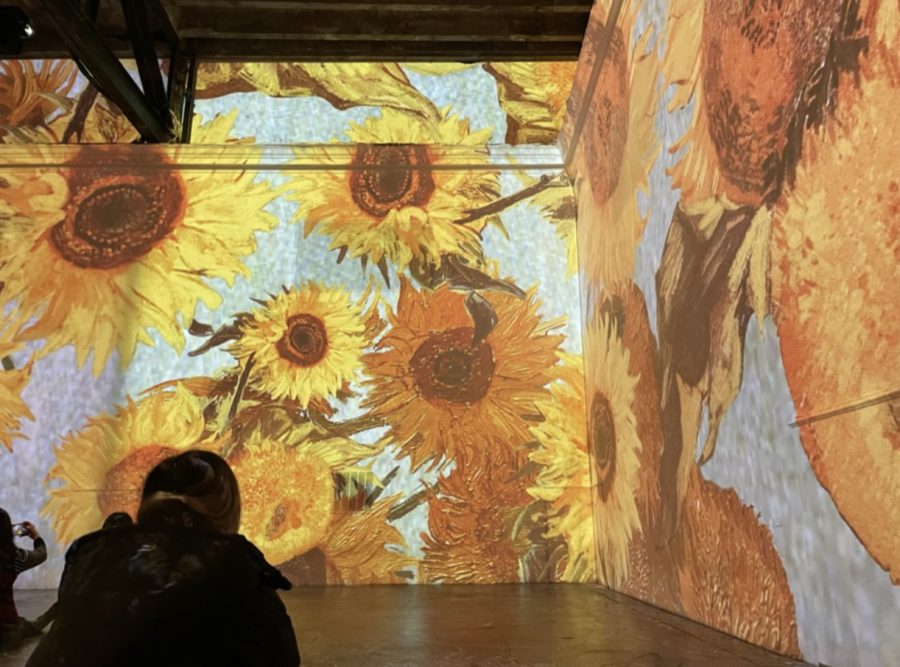Immersive Van Gogh Experience in Minneapolis
September 29, 2022
The Immersive Van Gogh Experience is an interactive traveling exhibit showing Vincent Van Gogh paintings through projected images on walls, accompanied by music and sound. Originally created by Annabelle Mauger in 2008, the idea of a Van Gogh Experience has been growing in popularity since being featured on the Netflix show “Emily in Paris” in 2020 and becoming a popular photo-taking destination.
The currently-touring exhibit was designed by Massimiliano Siccardi, with a curated soundtrack by Luca Longobardi and scenic design by Randy Wong-Westbrooke. Van Gogh Immersive traveled to Minneapolis in Aug. 2021, and the installment was extended twice: once, until April 22 2022, and again on July 1 2022. The installation remained in the Lighthouse ArtSpace in Minneapolis until Sept. 11.
Siccardi’s exhibit design intends to explore some of the most interesting aspects of Van Gogh’s subject matter and the way he saw the world. Van Gogh struggled with bipolar disorder, depression, schizoaffective disorder, malnutrition and several sexually transmitted diseases. Historians have been able to diagnose these conditions primarily through Van Gogh’s letters to Theo, who was his brother and the last person with whom he was known to have been in contact. He lived alone at the end of his life, and it is widely accepted that he took his own life as a result of his mental illnesses. Despite this, his artwork is known for depicting scenes of beautiful ordinary life.
For example, a major point of interest in Van Gogh’s work is the way he sees color. He was fascinated by yellow tones: he lived in a yellow house, painted primarily with yellow and used sunflowers as his primary subject. Art historians claim that his obsession could have been caused by two external issues: an overuse of medicine changing his vision and an overconsumption of absinthe, causing him to see the world around him with a hint of yellow. Regardless of the reason for his love of yellow, the color has been interpreted as a sign of happiness and later as a sign of illness, especially as it reflects the concept of life and light through sparks in “Starry Night” and the shades of yellow in “Sunflowers.”
The audience starts the Experience by stepping into a completely dark room in silence. There, they can either stand or sit on cushions and can see a full canvas of paintings on any surface of the room. The Experience is a 360° surrounding projection of images that spill over the walls and onto the ceiling continuously, starting with small splashes of paint and extending into fully developed oil paint pieces.
The opening sequence of flashing lights and overwhelming insect noises is meant to reflect both the flashing in Van Gogh’s deteriorating eyesight before his death and the insect infestations in his workspace that he described in letters. The audience travels through 14 different stages, each filled by a painting, accompanying music and surrounding sounds. Through extended transitions between paintings, the viewer experiences the blending of Van Gogh’s styles and the contrast between some of his previous paintings. These depict anything from starving farmers in gray and brown tones, like in “The Potato Eaters,” to vibrant landscapes and flower-based work like in “Sunflowers” and “The Red Vineyard.” Music also changes in tone, volume and genre throughout the Experience, from Edith Piaf’s booming “Je ne Regrette Rien” to soft piano in Van Gogh’s nighttime scenes.
As the intensity and tension of the paintings increases, so does the volume of the music and the surrounding noise. On the exhibit website, Longobardi describes the role of the music and says that “the soundtrack of this work of art develops by following two main narrative concepts: the human and emotional condition of the artist and his way of expressing his sensitivity through creative action.” The show is a loop, and closes in darkness to restart for the next wave of audience members.
The Immersive Experience has served as inspiration for several other artistic adaptations and responses to Van Gogh’s work — one exceptional example is the recent film “Loving Vincent,” which follows the artist’s life through entirely painted frames. The film is artistically impressive as it uses a medium never explored before in filmmaking, but it is equally impressive in the voice it gives Van Gogh through the story of his life.
“Loving Vincent” is just one of the many significant media responses to Van Gogh’s life and work, and has received similar popularity as the Immersive Experience, especially as it came out around the same time the experience started gaining media traction. Both these responses to Van Gogh’s life share the goal of creating an empathetic experience for the audience and its relationship to art.
The artist’s statement on the exhibit states that “this is called Immersive Van Gogh with good reason. The projected images and haunting musical soundscape will surround you and make it impossible for you to react passively. You will not be presented with completed works that you can study dispassionately. Siccardi wants you to understand, no, to feel, what the act of creation must have been like for Van Gogh.”
Depictions of Van Gogh’s visions and perspective on the world speak to the human experience of illness, beauty and love in unique and moving ways.
The Immersive Experience is headed next to Baltimore, Maryland and the presale for tickets opened this week. Information about upcoming immersive experiences at the Lighthouse, including a Monet Exhibit, will be announced soon. For more information, go to vangoghexpo.com.












